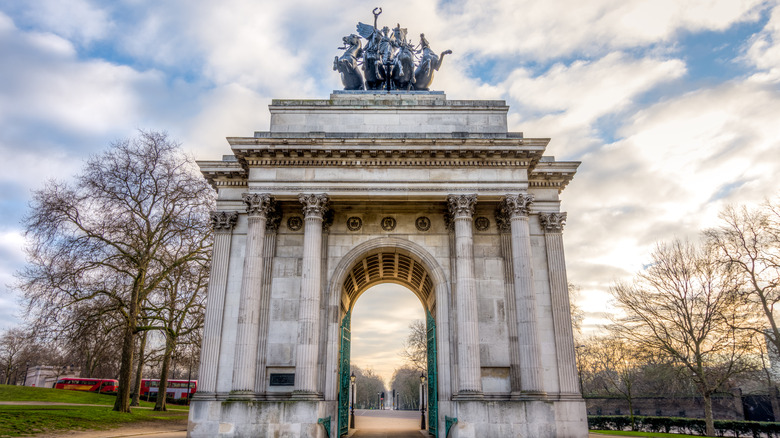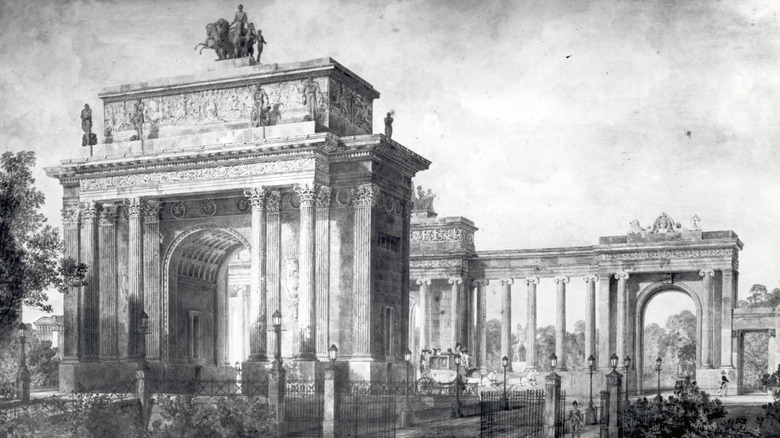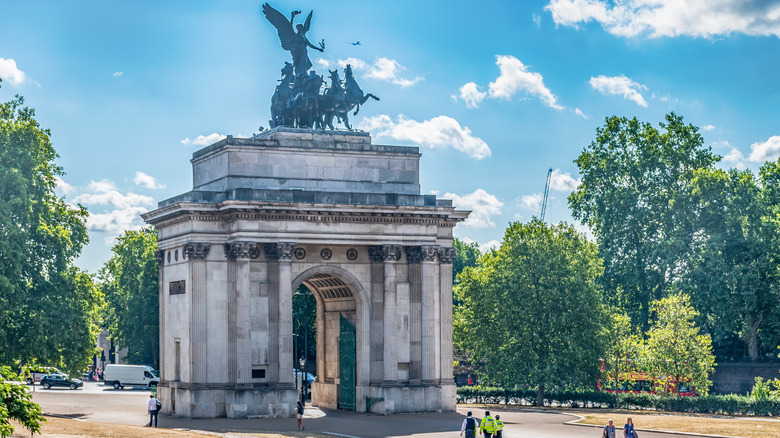The Significance Of London's Wellington Arch Explained
First constructed as the entrance to Buckingham Palace, the Wellington Arch stands as one of London's foremost landmarks. Built between 1825 and 1827, the structure currently stands at Hyde Park between Kensington Road and Piccadilly. Preceding its erection, 18th-century and post-Napoleonic architects toyed with ideas about a possible archway with the grandeur of the one seen today (via English Heritage).
According to Malcolm Chase's "1820: Disorder and Stability in the United Kingdom," by the 1820s, England was in an economically stable place, despite the revolutionary climate of the time. And by this decade, per English Heritage, the majestic Wellington Arch would become a symbol of English imperialism and, more recently, a popular attraction for tourists.
With a stairwell that takes visitors to a peak with an impressive view of such spots as the House of Parliament and the Queen's Garden, the Wellington Arch represents a truly singular part of London's landscape. So important is this landmark that on September 19, 2022, Queen Elizabeth's funeral procession will travel from Westminster Abbey to the Wellington Arch before going on to St. George's Chapel, per Sky News.
The early history of the Wellington Arch
In 1824, an architect named Decimus Burton was commissioned by the Office of Woods and Forests to create new structures in the parks that would conform to the new metropolitan spirit of London. The British Museum and Regent's Park had resulted from this desire to celebrate England's status as an empire. Burton's first designs for an archway into Green Park were considered but ultimately deemed too modest for an entrance to Buckingham Palace, which itself was in the process, at the time, of a remodel (via English Heritage).
In response, Burton took the design reins yet again to produce a "triumphal arch" adorned with sculptures that gave it all the imperiousness George IV sought. Burton even added the appropriate symbol of a gold quadriga (a chariot drawn by four horses) to draw a comparison between England and the Roman Empire.
But this addition shot beyond budget limitations, and there appeared to be no money left for the sculptures that would turn the Green Park Arch into the "triumphal" one it was intended to be. By 1928, a less decorative arch was all but finished but still awaited its adornments (per English Heritage). According to Frommer's, the arch was completed in 1830, but the version seen today was still years away.
Its history from 1830 to today
England became interested in creating memorials not long after the erection of the Green Park Arch. Since it was across the way from the Duke of Wellington's home, a committee suggested that a statue of Wellington on a horse should sit atop the arch.
This decision was not without controversy, as the members who pushed for a Wellington memorial did so through slippery means that left many committee members out of the decision process. The laughably large statue was mocked when it was erected and eventually it was removed in the 1880s (via English Heritage).
At the time it was removed, a new road was being built to prevent growing traffic jams around Hyde Park Corner. This meant the Wellington Arch had to be dismantled and moved to a nearby site across from Constitution Hall, which led to the arch sometimes being referred to as Constitution Arch. They took this opportunity to send the bulbous statue galloping on its way to a new spot at Garrison Church. In the 1890s, a bronze "Angel of Peace" quadriga (finally) made it to the perch of the arch.
Today, the site is run by English Heritage and has many functions as a tourist attraction, including a museum, an event space, and a viewing spot, per The Heritage Guide to the Constitution. On Monday, September 19, however, the Wellington Arch will be closed (and remain closed until September 21) in honor of the queen's funeral.


